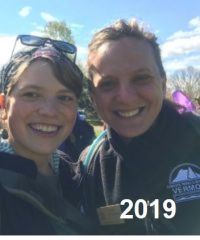your help is So Important, Thank you!
We rely on our observers to help record invasive plant phenology throughout Vermont. This project differs from past phenology projects because we will be monitoring specific invasive plants at specified sites across the state.
Wait - what is "phenology" exactly? Phenology means studying the timing of recurring life cycle events in living things, in our case - plants!
Participation in this project is straight forward -- all you need is a Nature's Notebook account, a smart phone or computer, and the ability to regularly return to your site to make observations.
What is involved:
- Log phenology observations at predetermined sites for specific invasive plants
- Upload those observations through Nature's Notebook
- Receive regular updates from our project leads about our progress
- Communicate your availability (if you can't make a week, or want to switch a week, no worries, just please let us know so we can find coverage!)
Time commitment:
- The time spent observing will be minimal. So not including travel to and across your site, expect to spend 1-3 minutes per plant each time you observe, which could be 1-3 times per month for study areas with multiple observers. Observations will take place most likely April through October (this is dynamic based on what we are seeing).
Who is involved:
- This project is run by the Invasive Plant Program at the Vermont Department of Forests, Parks & Recreation. We are part of the Forest Protection team. Project leads, and your main contacts, are Elizabeth (she/her) & Lina (she/her), pictured below. We look forward to working with you!

We’d like to acknowledge the financial and technical support provided by the USDA Forest Service, Northeastern Area State and Private Forestry that enables us to run projects and provide outreach such as this, and to our major project partner, the National Phenology Network, bringing together community members, scientists, managers, and educators, to advance the science of phenology.
Join us!
See below for the training needed to participate. The training is self-paced, and can be completed in one go, or piece meal. Overall, expect to spend 2-3 hours with the material and setting up your account.
Training
The material below teaches you how to participate in the Vermont Invasive Plant Phenology Project. People involved with this project will observe honeysuckle (Lonicera morrowii), buckthorn (Rhamnus cathartica), and bittersweet (Celastrus orbiculatus).
The Vermont Invasive Plant Phenology Project (VIPPP) is a project utilizing National Phenology Network's database and their online mapping tool, Nature's Notebook.
Our focus will be on establishing a baseline dataset (there’s currently an absence of strong, widely available data!) for invasive plant phenology in Vermont. With this baseline data, we’ll be able to track phenological shifts that occur due to climate change, and use the data in real time to help plan for and manage invasive plants effectively. The information collected is invaluable for informing how state lands are managed, as well as how land stewards, communities and landowners plan, budget, and implement terrestrial invasive plant control efforts.
Training material below includes:
- Getting Started with Nature's Notebook
- Identification and Phenophases
- How to Observe for VIPPP
Before you get going:
⭐ Depending on how you learn, it may be useful to have a way to take notes (digital or written) to refer to later.
⭐ Need a quick refresher or are new to observing plants? Click here to check out our Plant ID Glossary, or click here to check out this Teaching Plant ID worksheet. Want a deeper dive? Click here to check out Nature's Notebook's Glossary.
1. Getting started with nature's notebook
This part of the training should take 1-1.5 hours to complete.
Let's get you set up with the tools to observe. Follow the link below to complete the training on joining Nature's Notebook, creating an account, and learning how to use the website and phone app!
Click here to learn about getting started with Nature's Notebook. You can start/stop the training at any point, and return to it as many times as you'd like even after hitting "submit".
2. Identification and Phenophases
This part of the training should take 1-1.5 hours to complete.
Now that you are set up with the tools to observe, let's set up the information you'll need for observing. Observers will be monitoring already tagged plants, but understanding how to identify the species will support your learning of the phenophases for those plants. Follow the link below to complete the training on identification, phenophase status, and practice those skills!
Click here to learn about identification and phenophases of Lonicera morrowii, Rhamnus cathartica, and Celastrus orbiculatus. You can start/stop the training at any point, and return to it as many times as you'd like even after hitting "submit".
Level Up Your Observation Skills
Phenophase Intensity (coming soon!)
- Leaves
- Flowers
- Fruit
3. How to Observe for VIPPP
-
As an observer for VIPPP, you'll be assigned to a specific study area, where there will be three sites you'll monitor with each visit.
At each site you'll observe 1-3 individual plants.
You will either be:
- a study area lead (responsible for setting up sites and individual plants for observation, as well as making and recording regular observations)
- a study area observer (responsible solely for making and recording regular observations)
FPR Monitoring Protocols
For Study Area Leads
For Everyone (Study Area Observers & Study Area Leads)
- Status Monitoring (Observing & Recording)
Click here to access the 'How to Observe' handbook covered in Module 1.
